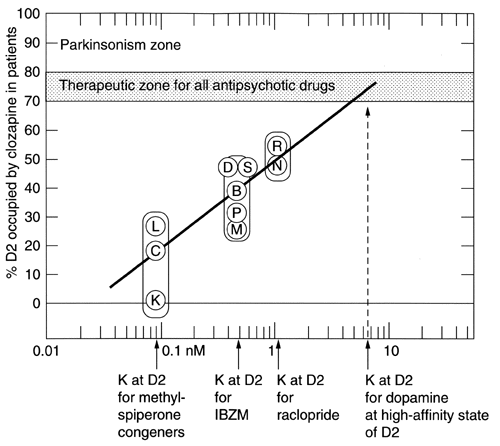
| Figure 7. |
 |
| The occupancy of D2 by clozapine rises when radioligands with higher dissociation constants are used with PET or SPET. The radiolabeled methylspiperone congeners were [18F]methylspiperone (K: 69), [11C]methylspiperone (C: 28) or [18F]fluorethylspiperone (L: 92, 93), all of which have a dissociation constant of 0.092 nM (this lab, unpublished). Clozapine occupied higher levels of D2 receptors (D:131; S:180, 181; B:19; P:132; M:73) when [123I]iodobenzamide was used (dissociation constant of 0.43-0.49 nM). The highest level of D2 receptors was occupied by clozapine (N: 117; R: Kapur S, personal communication, 1996) when [11C]raclopride was used (dissociation constant of 1 nM; Table 1). In other words, the D2 occupancy by clozapine is directly related to the dissociation constant of the radioligand. Under therapeutic conditions, however, it is necessary for the antipsychotic drug to compete against dopamine, which has a dissociation constant of 2–7 nM for the high-affinity state of D2. Thus, extrapolating to this range of 2–7 nM results in a prediction that 75% of the D2 receptors will be occupied by clozapine under clinical conditions. Antipsychotic doses of haloperidol or other traditional antipsychotic drugs occupy 70–80% of brain D2 receptors (20,30,54-56), as measured using [11C]raclopride. |
published 2000